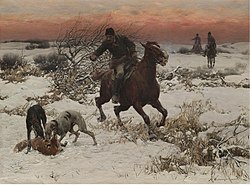This article includes a list of general references, but it lacks sufficient corresponding inline citations. (July 2009) |
Coursing by humans is the pursuit of game or other animals by dogs—chiefly greyhounds and other sighthounds—catching their prey by speed, running by sight, but not by scent. Coursing was a common hunting technique, practised by the nobility, the landed and wealthy, as well as by commoners with sighthounds and lurchers. In its oldest recorded form in the Western world, as described by Arrian—it was a sport practised by all levels of society, and it remained the case until Carolingian period forest law appropriated hunting grounds, or commons, for the king, the nobility, and other landowners. It then became a formalised competition, specifically on hare in Britain, practised under rules, the Laws of the Leash'.[1]

As a zoological term, it refers to predation by running down prey over long distances, as opposed to stalking, in which a stealthy approach is followed by a short burst of sprinting. Humans also employ coursing as a means of hunting, but the term is normally reserved for predation by non-human predators.[2][3]
Sport and hunting
editAnimals coursed in hunting and sport include hares, foxes, deer of all sorts, antelope, gazelle, jackals, wolves. Jackrabbits and coyotes are the most common animals coursed in the United States. Competitive coursing in Ireland, the UK (until prohibition in 2004), Portugal and Spain has two dogs running against each other. In the United States, generally speaking, three dogs are run together.
The Protection of Wild Mammals (Scotland) Act and the Hunting Act 2004 (in England and Wales) made it illegal to hunt any type of mammal with dogs with the exception of rabbits and rats. Dogs are still permitted to chase (flush) game into the path of a waiting gun, as long as no more than two dogs are used.
In Australia, dogs may be used to hunt feral animals such as foxes, deer, goats, rabbits, and pigs.[4]
See also
edit- Hare coursing
- Greyhound racing
- Lure coursing
- Cheetah and Caracal – two feline species also historically used in similar hunting practices
- Courser (disambiguation)
References
edit- ^ Johnson, Thomas Burgeland (2023) [1848]. The sportsman's cyclopaedia : comprising a complete elucidation of the science and practice of hunting, shooting, coursing, racing, fishing, hawking, cockfighting, and other sports and pastimes of Great Britain, interspersed with entertaining and illustrative anecdotes [LeatherBound]. p. 193.
- ^ Montgomery, Robert A., et al. The hunting modes of human predation and potential nonconsumptive effects on animal populations. Biological Conservation 265, 2022: 109398
- ^ MacNulty, D.R., et al. A proposed ethogram of large-carnivore 395 predatory behavior, exemplified by the wolf. Journal of Mammalogy, 88(3) 2007, pp.595-605
- ^ "Boardogs Deerhounds". Retrieved 23 July 2016.
Further reading
edit- Blanning, Charles. The Greyhound and the Hare: A History of the Breed and the Sport. The National Coursing Club, 2018.
- Blanning, Charles. Twenty Two Waterloo Cups 1981-2005. Charles Blanning, Fullerton Press in association with the National Coursing Club, 2022.
- Cox, Harding Edward de Fonblanque. Coursing and falconry 1899 [1]
- Copold, Steve. Hounds Hares & Other Creatures: The Complete Book of Coursing 1977/1996
- Dansey, William. Arrian On Coursing: the Cynegeticus London: J. Bohn, 1831 [2]
- Macpherson, H. A. The hare 1896 [3]
- Phillips A.A. & Willcock M.M. Xenophon & Arrian On Hunting with hounds 1999
- Grant-Rennick. Coursing, The Pursuit of Game with Gazehounds 1976 [4]
- M. H. Salmon ("Dutch"). Gazehounds & Coursing: The History, Art, and Sport of Hunting with Sighthounds, Rev. and expanded 2nd ed. Silver City, N.M.: High-Lonesome Books, 1999. ISBN 0-944383-49-1.
- Stable, Owen QC, & Stuttard, R.M. A Review of Coursing British Field Sports Society, London 1971
- Turbervile (Gascoigne), George. The Noble Art of Venerie or Hunting 1576. See page 246 "A short observation ... concerning coursing" [5]
- Walsh, Edward G. Longdogs by Day 1990